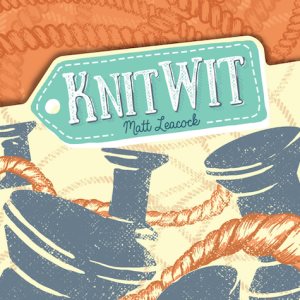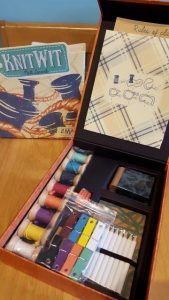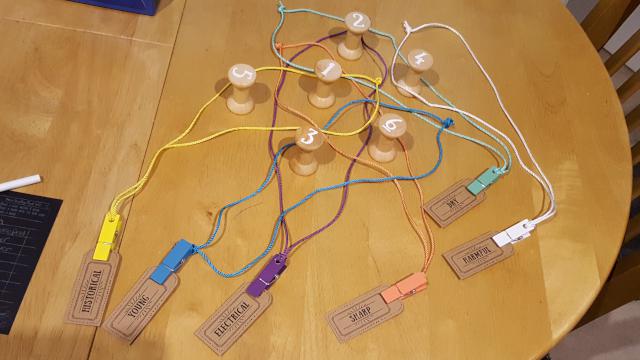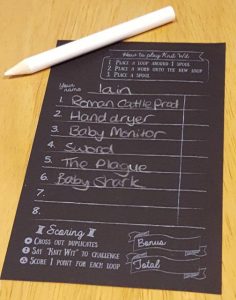
Let’s get one thing straight from the start – Knit Wit is a beautifully presented game. From the box itself, through to the wooden spools, tiny clothes pegs and blackboard-style score cards, this game oozes quality in terms of its build quality. Judging a game purely on that obviously wouldn’t be a wise idea obviously, but considering that’ the first thing I noticed when I opened up Knit Wit, it felt only right to open the review with the same observation. The game itself, as I’ll do my best to explain, is every bit as enjoyable as opening up the box for the first time.

Knit Wit is very much a party game; games take less than 20 minutes, have a clear winner at the end and can be turned round ready to start again in moments. Some people have a tendency to use “party game” as a derogatory expression, a label for games which don’t have the required complexities to be considered a worthwhile addition to their collection, but I’m assuming these are the kinds of people who also haven’t played games like Codenames, every bit as much of a party game but still seen by many (including us) as one of the most enjoyable games around. In fact Knit Wit shares some of the base concepts of Codenames, while still carving out a very unique and fun game.
The idea of Knit Wit revolves around trying to dream up obscure words or phrases which link other words together, without anyone else making the same connection. During the setup phase loops of wool are attached to small clothes pegs and placed on the table (which, incidentally, will need to be a decent size if you want to make this easier to play). After each one is placed a numbered spool is positioned somewhere on the table within the loops, in such a way that it encompasses a combination of loops not already used (if you’re confused take a look at the photo below, it helps to make sense of this…). Words are also clipped into the clothes pegs, essentially giving each numbered spool a combination of words associated with it. In the example below, spool number one is inside the yellow, pink and purple loops, giving the players the words “historical”, “electrical” and “sharp” to work out how to link together.

Once all the loops, spools and words are in place it’s time for each player to come up with something to link each spool’s words together. In this instance I struggled with spool 1, going for what I can only assume was a useful farming item a few years back: “Roman Cattle Prod”. Spool number 4 offered “Dry” and “Harmful”, so I went basic with “Sword”, knowing that this was a bit risky as such an obvious answer. These get written by the player onto their awesome black scorecards pictured below using the white pencils provided in the box. This serves no practical difference to scoring at all, but there’s something very cool about the blackboard style scorecards and with them being double sided as well it’ll be a good while before you run out and have to grab a nearby notepad to keep score. Once someone decides they’ve got as many answers as they can come up with (or they’ve finished) they can grab a button off the top of the button pile; the earlier they do so the more bonus points they get at the end of the game, but as you’re not allowed to write any more after doing so it also means potentially rushing your answers and scoring less points in the first place.
If this all sounds too easy at the moment then don’t worry, there’s one big twist in the way you score points. Once everyone has finished you go through each spool and hear people’s answers. If two or more people have the same answer then you don’t get any points; you need a unique, relevant and hopefully amusing take on the words which are hooked onto that spool. If you manage to come up with something that makes no sense to other players they can challenge the answer, in which case you have 10 seconds to explain yourself before getting a thumbs up or down – fail to win them over and you’ve got a big zero next to that one as well. If, however, you manage to come up with a score-worthy answer then you’ll get points based on how many loops are on that spool – the more loops there are (and therefore the more words there are), the more points you get. Simple.
 With the scores totalled up you add on bonus points based on which button you’ve got (the number of holes on the button denote whether you grabbed a button first, second or whatever) and come up with a final tally. Whoever has the most points, you’ll be surprised to hear, wins.
With the scores totalled up you add on bonus points based on which button you’ve got (the number of holes on the button denote whether you grabbed a button first, second or whatever) and come up with a final tally. Whoever has the most points, you’ll be surprised to hear, wins.
It’s very easy to get the hang of, and after one game you’ll probably find that everyone knows what’s going on and will want to play again. And again. And, probably, again. If you’re happy to accept slightly more unusual answers with tenuous links to the words in question then you can end up with some hilariously bizarre suggestions, which opens up the game to be even more enjoyable with a few friends. Playing with only 2 players works fairly well too, but the challenge of getting unique words obviously increases as you bring in more people – I’d certainly recommend a group or more players joining in on this one.
So would I recommend Knit Wit? Most definitely. It’s a very simple but highly addictive game, and with each game being fairly short there’s a very strong “just one more game…” factor making a short game turn into a long evening of enjoyment. It’s looks and feels amazing, has some very well designed rules and will keep you laughing for quite some time. Who can say no to that?

Leave a Reply